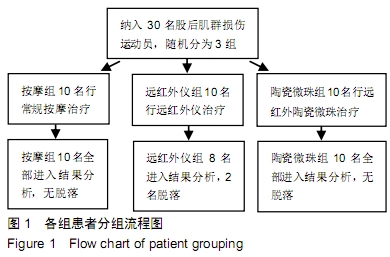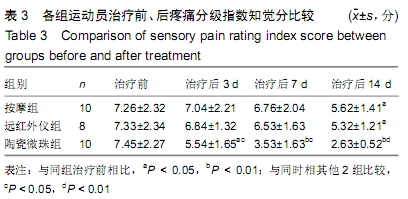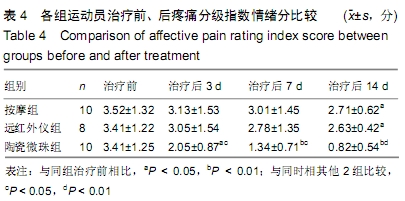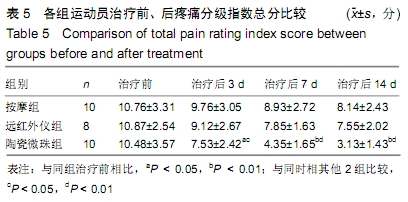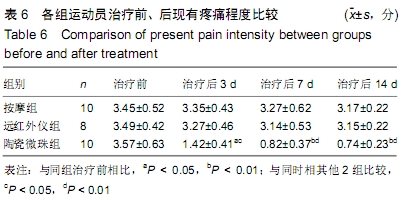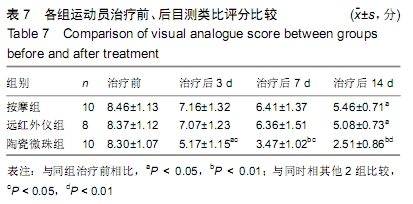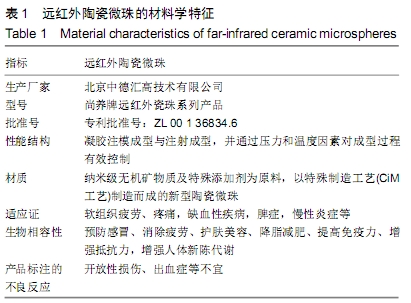中国组织工程研究 ›› 2020, Vol. 24 ›› Issue (16): 2561-2566.doi: 10.3969/j.issn.2095-4344.2288
• 材料生物相容性 material biocompatibility • 上一篇 下一篇
远红外陶瓷微珠干预下肌肉损伤疼痛分级指数、目测类比评分和现有疼痛程度的变化
何建伟1,2,张君梅3,张 莹4,许 剑1,杨小玲1
- 1广州大学体育学院,广东省广州市 510006;2莆田学院体育学院,福建省莆田市 351100;3武汉理工大学体育部,湖北省武汉市 430070;4浙江师范大学杭州幼儿师范学院,浙江省杭州市 310012
Changes in pain rating index, visual analogue score, and present pain intensity after far-infrared ceramic microsphere intervention for the treatment of muscle injury
He Jianwei1,2, Zhang Junmei3, Zhang Ying4, Xu Jian1, Yang Xiaoling1
- 1College of Physical Education, Guangzhou University, Guangzhou 510006, Guangdong Province, China; 2College of Physical Education, Putian University, Putian 351100, Fujian Province, China; 3Department of Physical Education, Wuhan University of Technology, Wuhan 430070, Hubei Province, China; 4Hangzhou Kindergarten Teachers' College, Zhejiang Normal University, Hangzhou 310012, Zhejiang Province, China
摘要:

文题释义:
远红外陶瓷微珠:以纳米级无机矿物质及特殊添加剂为原料,清华大学材料学院“新型陶瓷与精细工艺”国家重点实验室研制出的远红外陶瓷微珠产品,应用陶瓷胶态注射成型工艺制造而成,是运动康复以及日常保健领域中的一种新型理疗材料,以其独特的颗粒细小圆形结构能够完整覆盖敷于脚部、腰部、大腿等损伤部位进行全面刺激干预。
McGill疼痛量表评分:McGill评分是一种多因素疼痛调查评分方法,重点观察疼痛及其特点、性质、强度、伴随状态和疼痛治疗后患者所经历的各种复合因素与相互关系,能较准确地评价疼痛的强度和性质。
背景:清华大学材料学院“新型陶瓷与精细工艺”国家重点实验室研制出的远红外陶瓷微珠产品,应用陶瓷胶态注射成型工艺制造而成,是运动康复以及日常保健领域中的一种新型理疗材料,以其独特的颗粒细小圆形结构能够完整覆盖敷于脚部、腰部、大腿等损伤部位进行全面刺激干预。
目的:探讨远红外陶瓷微珠对肌肉损伤后疼痛程度的影响。
方法:选择18-21岁各体育专业符合股后肌群损伤诊断标准的在校学生30名,均对试验方案知情同意。随机分为3组,每组10名,按摩组进行按摩治疗,远红外仪组进行普通远红外治疗仪治疗,陶瓷微珠组进行远红外陶瓷微珠治疗,连续干预2周,治疗前与治疗后第3,7,14天测定McGill疼痛量表评分(包括疼痛分级指数、目测类比评分和现有疼痛程度),并进行组内、组间比较。
结果与结论:①疼痛分级指数(感觉分、情绪分和总分)、目测类比评分和现有疼痛程度3组治疗前相比,差异无显著性意义(P > 0.05),具有可比性;②陶瓷微珠组治疗3 d后各项疼痛评分均显著低于按摩组、远红外仪组(P < 0.05);治疗7,14 d后,陶瓷微珠组各项指标均显著低于按摩组、远红外仪组(P < 0.01);③陶瓷微珠组治疗3 d后,各项疼痛评分显著低于治疗前(P < 0.05);与同时相其他2组相比也显著降低(P < 0.05);④陶瓷微珠组治疗7 d后,各项疼痛评分显著低于治疗前(P < 0.01);与同时相其他2组相比也显著降低(P < 0.05);⑤治疗14 d后,按摩组、远红外仪组各项疼痛评分显著低于治疗前(P < 0.05);而陶瓷微珠组各项疼痛评分也显著低于治疗前(P < 0.01),与同时相其他2组相比也显著降低(P < 0.01);⑥提示远红外陶瓷微珠可有效减轻股后肌群受伤肌肉的疼痛程度,有效促进肌肉损伤的恢复。
ORCID: 0000-0002-9375-1940(何建伟)
中国组织工程研究杂志出版内容重点:生物材料;骨生物材料; 口腔生物材料; 纳米材料; 缓释材料; 材料相容性;组织工程
中图分类号:
